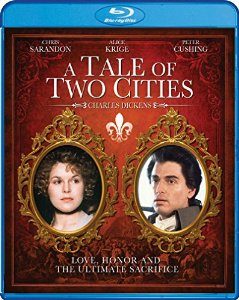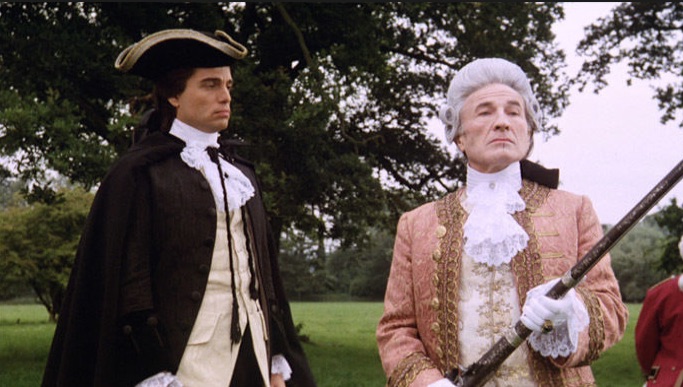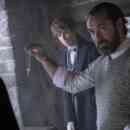Blu-ray blast from the past: A Tale of Two Cities
Reflections on the Revolution in France – from the man who brought you Shanghai Surprise: Jim Goddard’s adaptation of the Dickens classic still holds its edge, even in a 1980 Hallmark production starring Chris Sarandon and Peter Cushing
A Tale of Two Cities (1980)
3.5/5
Starring: Chris Sarandon, Alice Krige, David Suchet, Barry Morse, Peter Cushing
Directed by: Jim Goddard
Running time: 162 minutes
Blu-Ray release: Shout Factory

The Blu-ray release of A Tale of Two Cities has no special features
By Katherine Monk
Some movies may be sentimental and sloppy, but if you watched them as a kid, they seem to linger in a different memory bank – far away from the judge-y ranks of critical thought. So is the case with this 1980 movie based on Charles Dickens’s classic.
Earnest, overly long and void of any humour, it’s hard to know why this one lodged in long-term memory. But there it sits, along with its long scenes and poofy-sleeved costumes, coiled around some root of my core identity.
Just watching the opening scene was enough to re-ignite an early notion of social justice: A little boy is run over by a horse-drawn carriage carrying a French aristocrat (played with icy restraint by Barry Morse). The boy’s father wails with grief. The aristocrat drives off in a huff, irritated by the delay.
Other scenes triggered a similarly reflective reflex: A barrel of wine falls off the back of a wagon and spills into the streets, prompting a rush to the cobblestones as starving citizens use rags and clothing to sop up the ruddy puddles. A kind old doctor (played by Peter Cushing) is released from the dungeon, but refuses to surrender the cobbler’s tools that kept him company during his incarceration – calling them “old companions.” And, of course, who could forget the introduction of the guillotine as a new technology loyal to the revolution?
Those shots of the blood-covered blade, accompanied by a heavy thud and flesh-cutting sound effects, were enough to make me question capital punishment. By the same token, the sight of Morse killing pigeons for sport made me dislike the entitled and affluent – which means director Jim Goddard actually captured the full spirit of what Charles Dickens set out to achieve in his novel way back in 1859.
A beautiful antidote to the waves of political rhetoric lapping up on the shores of every network these days, Dickens’s story set against the backdrop of the French Revolution has no right side. Every one is a human being, capable of both good and evil. Some are even capable of the ultimate sacrifice – giving us one of the most memorable quotes in the English language: “It is a far far better thing that I do, than I have ever done; it is a far far better rest that I go to than I have ever known.”
As a kid, the final plot twist seemed so senseless. Why would a fun-loving lawyer like Sydney Carton ever switch places with a stick-in-the-mud like Charles Darnay? More urgently, why did Lucie Manette choose the dullard over the drunkard?
Even decades later, these are hard choices to grasp, but Goddard embraced the moral ambiguity. He pushes the viewer to look inward every time we feel an urge to judge, whether it’s the evil glare in Madame Defarge’s eye, or the heroic profile of our would-be hero Charles Darnay.
Chris Sarandon takes on the dual role of the doppelgangers on either side of the English Channel, fugitive French aristocrat Darnay and English lawyer Sydney Carton. Much of the performance seems to be hair-based – as it would be in these post-Shampoo years — but Sarandon looks good in period garb and knows how to don a cape, which may explain his appearance in The Princess Bride as Prince Humperdinck just seven years later.
Other familiar faces include Alice Krige as the aging ingénue Lucie Manette and David Suchet as the dastardly spy, but chances are, it’s the style and pacing of the film that hit the nostalgia button.
Without special effects, a massive cast or acrobatic action scenes, this Hallmark production didn’t pander to the lowest common denominator. (Goddard would get around to doing that a few years later when he directed Sean Penn and Madonna in Shanghai Surprise.)
Shot on location in Europe, the movie has the look of a PBS period show, only with a brighter palette and flat lighting. At times, it looks a little stiff, but it works – largely because it’s a very loyal adaptation of Dickens, and arguably, one of the best novels ever written.
“It was the best of times, it was the worst of times, it was the age of wisdom, it was the age of foolishness, it was the season of Light, it was the season of Darkness, it was the spring of hope, it was the winter of despair, we had everything before us, we had nothing before us…”
Dickens’s first lines may be 150 years old, but like the book as a whole, they feel timely if not downright urgent as we grapple with the growing income gap, the calls for revolution and the whispers of own conscience.
Special Blu-ray features: None.
@katherinemonk
THE EX-PRESS, May 31, 2016
-30-






No Replies to "Slicing Life: A Tale of Two Cities"